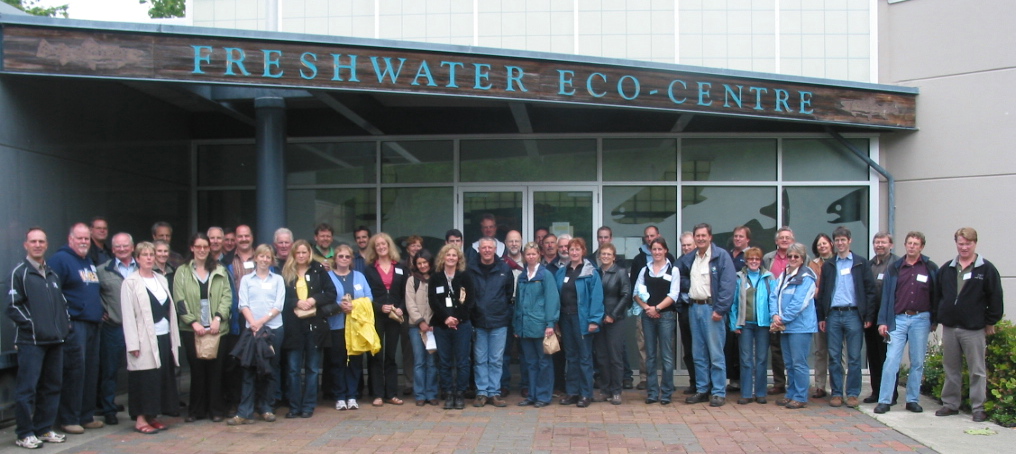SUSTAINABLE WATERSHED SYSTEMS: What is the provincial government role in supporting BC communities so that they “get it right” when moving from policy to action in implementing initiatives flowing from the Living Water Smart framework?
Note to Readers:
Released in June 2008, “Living Water Smart, British Columbia’s Water Plan” was the Province’s call to action create greener communities and prepare for climate change. To this day, Living Water Smart transcends governments. The ripple effects resulting from transformational initiatives inspired by Living Water Smart are reverberating through time.
Look back to look forward. What have we learned? How do we pass that understanding (of what we have learned over the past 10 years) onto successive generations of land use, infrastructure and asset management professionals who do their work in the local government setting? How can we help them make informed choices that benefit from past experience? These are just some of the questions that guide the work of the Partnership for Water Sustainability in British Columbia.
Looking back, launch of the Living Water Smart outreach program commenced with a precedent-setting approach to capacity-building in the local government sector. Known as the 2008 Vancouver Island Learning Lunch Seminar Series, and delivered through the CAVI-Convening for Action on Vancouver Island initiative, this capacity-building program was a “grass-roots” demonstration application of how to build inter-departmental and inter-governmental alignment.
Both the Cowichan Valley Regional District and City of Courtenay stepped up to the plate and volunteered to host a regional seminar series. A decade later we celebrate their leadership as early adopters; and we reflect on what their efforts set in motion, and what comes next in the capacity-building process.

Download a copy: https://www2.gov.bc.ca/assets/gov/environment/air-land-water/water/water-planning/livingwatersmart_book.pdf
“All land and water managers will know what makes a stream healthy, and therefore be able to help land and water users factor in new approaches to securing stream health and the full range of stream benefits”
– lynch-pin statement in Living Water Smart, p. 43
 “In 2008, the desired outcome in bringing together local governments on the east coast of Vancouver Island (for the Learning Lunch Seminar Series) was inter-departmental alignment and a consistent regional approach to implementing Living Water Smart,” stated Kim Stephens, Executive Director of the Partnership for Water Sustainability in BC.
“In 2008, the desired outcome in bringing together local governments on the east coast of Vancouver Island (for the Learning Lunch Seminar Series) was inter-departmental alignment and a consistent regional approach to implementing Living Water Smart,” stated Kim Stephens, Executive Director of the Partnership for Water Sustainability in BC.
“The Partnership championed a ‘regional team approach’ to sharing and learning from each other’s experience.”
Journey from policy to universal implementation:
Where to from here
The provincial government has long recognized that communities are in the best position to develop solutions which meet their own unique needs and local conditions. Further, BC’s regulatory environment for urban watershed protection is outcome-based.
A provincial policy, program and regulatory framework is in place that would result in Sustainable Watershed Systems, through Asset Management. This framework enables local governments to bridge the gap between policy and action. But it relies on collaborative processes to build practitioner capacity to implement requisite changes in accepted practice.
Nature of the Capacity-Building Challenge
- continual staff turnover is the “new normal” within local government;
- there is limited capacity for senior staff to “pause & reflect”; and
- there has been a loss in mentorship from retiring staff in how to implement policy.
Role of the Provincial Government
British Columbia is at a tipping point vis-à-vis Sustainable Watershed Systems. Without provincial government leadership and direction, the process to adopt, change or evolve standards of practice and apply tools in the local government setting may be painfully slow, might not happen, or could simply peter out due to indifference or neglect.
As a minimum, provincial government support is necessary if communities are to “get it right” from a water balance perspective vis-à-vis land use, infrastructure servicing of land, and asset management.
An example of a driver for changes in practice that has the potential to truly be a difference-maker over time is Asset Management for Sustainable Service Delivery: A BC Framework. This game-changer flows from Living Water Smart, resulted from “grass-roots” collaboration, and supports outcomes that reduce life-cycle costs and address risks.
While the BC Framework is an important step in a capacity-building process, there is still a long journey ahead. Leadership and coordination by the provincial government, sustained over time, are essential ingredients that would help communities achieve the vision for Sustainable Watershed Systems.
A decade ago, the genesis….
Regional Team Approach
Although the Leadership Forum itself was a successful event, it was clear that there had to be a more effective and lasting way to inform and educate those who would benefit most. The concept was to bring together engineers, planners, building inspectors and bylaw enforcement officers; and focus on aligning efforts to implement effective green infrastructure.
The idea resonated, so much so that the original inter-departmental concept quickly mushroomed into an inter-departmental AND inter-governmental concept. Each series comprised three all-day seminars. The Cowichan Valley Regional District hosted the first series in June and July 2008. The City of Courtenay hosted the second series in September, October and November 2008.
The Story of the 2008 Series:
Five provincial guidance documents formed the curriculum backbone. Local case study experience informed the program design.
The approach to continuing education for local government practitioners was precedent-setting.
Each series comprised three sessions that provided an inter-departmental learning opportunity for collaborative exploration.
Each series was conducted as a cumulative process, from philosophy to tools.
The story of the series is captured in a document published by the Partnership. “The purpose of the document was to ‘tell the story’ of the 2008 Vancouver Island Learning Lunch Seminar Series in the words of those who embraced the concept and made it happen. The Learning Lunch series was precedent-setting,” stated John Finnie, CAVI Past-Chair (2006-2011). At the time, he was General Manager of Water & Wastewater Services at the Regional District of Nanaimo.
 “It came to fruition because of the commitment, the energy and the dedication of our local government partners in three regional districts – Cowichan, Comox and Nanaimo. We endeavoured to weave a seamless storyline that shows how the Learning Lunch series fits into a bigger picture; and how the program elements that comprise Convening for Action on Vancouver Island are linked. Each success built on the last, and paved the way for the next.”
“It came to fruition because of the commitment, the energy and the dedication of our local government partners in three regional districts – Cowichan, Comox and Nanaimo. We endeavoured to weave a seamless storyline that shows how the Learning Lunch series fits into a bigger picture; and how the program elements that comprise Convening for Action on Vancouver Island are linked. Each success built on the last, and paved the way for the next.”
A substantive outcome: the Georgia Basin Inter-Regional Educational Initiative (IREI)
Experience and relationships flowing from the 2008 Vancouver Island Learning Lunch Seminar Series ultimately led to the Georgia Basin Inter-Regional Education Initiative (IREI).
Launched in 2012, the IREI brought together five regional districts, namely: Capital Region, Nanaimo Region, Cowichan Valley, Comox Valley and Metro Vancouver. Together, they represent 75% of British Columbia’s population. All five Regional District Boards have passed resolutions supporting inter‐regional collaboration under the umbrella of the Partnership for Water Sustainability.
The educational goal of the IREI is to build practitioner capacity within local government to implement a whole-system, water balance approach branded as Sustainable Watershed Systems, through Asset Management. The Partnership is developing approaches, tools and resources that would advance “design with nature” outcomes through collaborative processes.

participants in the 2008 Learning Lunch Seminar Series hosted by the Cowichan Valley Regional District

